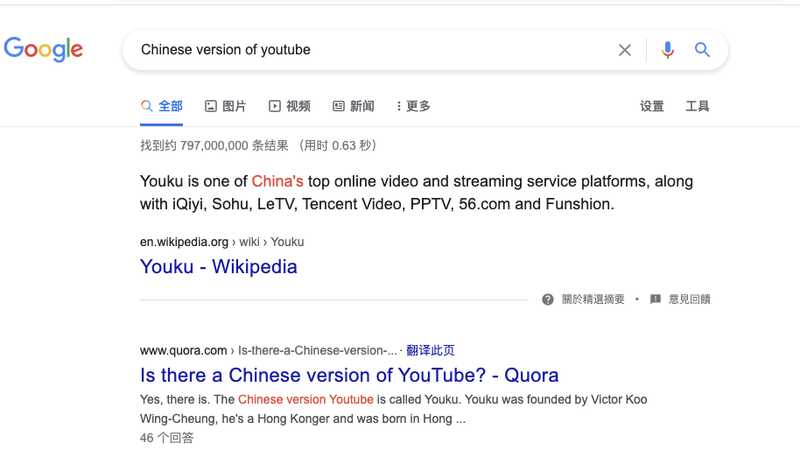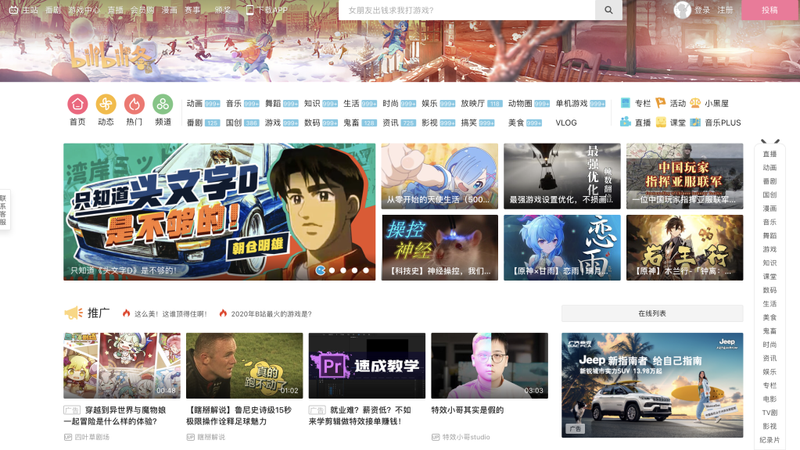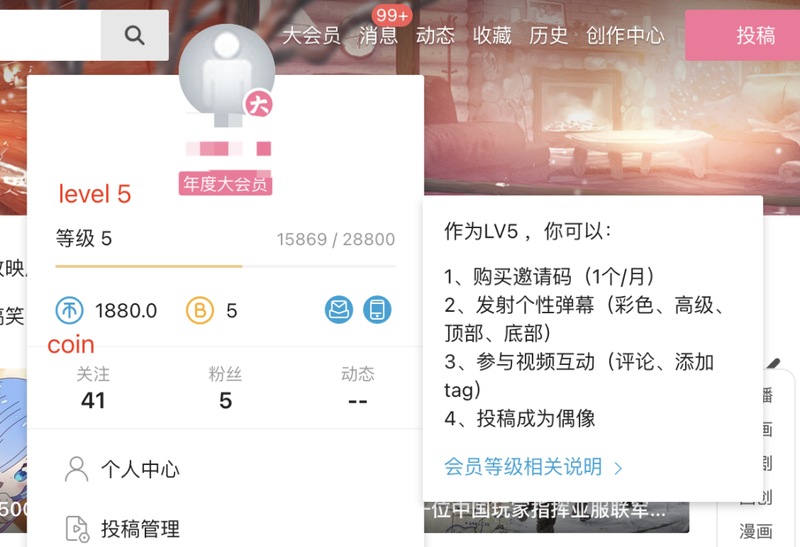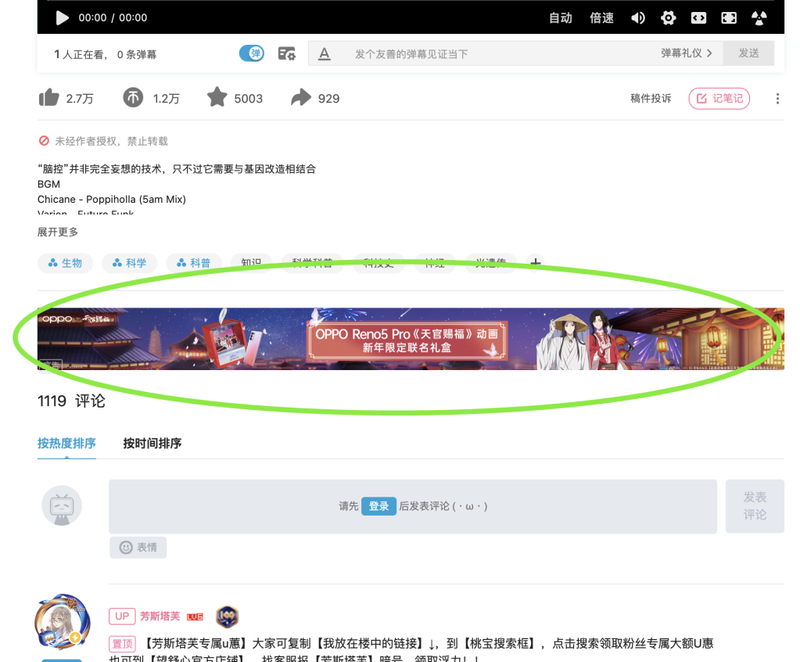icon
password
Multi-select
tags
ID
type
status
slug
summary
category
date
Author
URL
Due to the influence of COVID-19, video websites around the world have gained more revenue.
In the United States, Youtube and Tiktok have become the main forms of entertainment to fill people’s blank time. As you all know, Tiktok itself comes from China, so it has a Chinese version of Douyin. The Chinese also waste a lot of time on Douyin.
But for most foreigners, they may wonder if China has its own Youtube. If you ask Google, it still gives an outdated wrong answer:

Yes, many video websites in China had claimed that they will become the Chinese version of Youtube. For example, Youku, the earliest video website in China, and Tencent Video, a video site from the Chinese social giant.
But in the long competition, they all changed their positioning. The three largest video websites in China, Youku,iQiyi, and Tencent Video, now look like China’s Netflix in terms of product positioning. Although they still retain the ability for users to upload videos, most users visit the three sites to watch online TV dramas.
Another site, bilibili, which won 200 million monthly active users in 2020, is becoming the most Youtube-like Chinese site.
If you have ever known the major social networking sites in China, you may want to refute me: bilibili is just a gathering place for Chinese animation enthusiasts, not Youtube.

bilibili.com
This view used to be correct, but after the company went public in 2018, it quickly abandoned its original ACG cultural community positioning and evolved into a video site for Chinese young people, which made it look very similar to Youtube.
Let’s talk about it in detail.
A brief history of bilibili
Bilibili launched in 2009, and unlike Youtube, its initial goal was not to become a video site for everyone to use.
Because at that time, three other Chinese video sites, Youku, Tencent Video, and Tudou, had been online for a long time. All three sites are commercially run and backed by venture capital, and no one wants to challenge them.
On June 26, 2009, a website called MikuFans was launched, as its name implies, a fan community focused on sharing videos related to Japanese virtual idol Miku. Its founder, ⑨bishi, is one of the star users of ACFun, another ACG Fandom video site in China.
For a long time when Mikufans was launched, there were few users because it was just a simple copycat of AcFun and AcFun was just the copycat of the Japanese video site Niconico.
AcFun is a Chinese video website founded in 2007, which is limited to sharing videos related to Japanese animation. During that time, it was the main channel for Chinese people to watch pirated Japanese animation online.
In January 2010, Mikufans changed its name to bilibili, which comes from the title given to the heroine Misaka Mikoto by Kamijou Touma, the hero of the Japanese light novel and animated work A Certain Magical Index. This is a Japanese onomatopoeia word used to describe static electricity noise.
This year, AcFun began to enter a turbulent period because of management problems, revenue pressure, and tort litigation. Over the next 7 years, the ease of use of AcFun became worse and worse. Their executives were charged and jailed for spreading pirated animations. They changed several leaders and brought in a lot of investment, but no one succeeded in saving the site. China’s largest community of animation fans has become almost unavailable.
For those animation enthusiasts who have lost their “homeland”, there is only one place of redemption: bilibili.
A large number of users fled from AcFun to bilibili. Because of its symmetry in the text, AcFun is called A Site, and bilibili is called B Site. This title has been retained to this day.
In 2011, the first business entity of bilibili was registered in Hangzhou. Bilibili has changed from a founder-driven “interest community” to an enterprise. It received its initial venture capital investment in 2013 as IDG. After that, SMG, Tencent, and Alibaba invested in it respectively. This allows it to have both overseas investment, state-owned capital investment, and investment from China’s two largest Internet companies.
SMG is the abbreviation of Shanghai Media Group, which is a state-owned enterprise, mainly engaged in Shanghai TV station and related network business. SMG, as an important shareholder of bilibili, to some extent helped bilibili to achieve compliance and avoid becoming a second AcFun.
Over the next few years, bilibili gradually began to remove pirated content from its website. It is worth noting that bilibili did not abandon animation lovers during this period. They have purchased a large number of Japanese animation copyrights, provide ad-free free streaming services, and can look back at any time. This makes many Japanese come to bilibili to watch animations of their own countries. Due to copyright restrictions, bilibili soon banned overseas users from accessing the animations.
On March 28, 2018, bilibili went public on Nasdaq. After the listing, the company’s strategy has changed significantly.
Also See: History of Nijigen Culture in China
Previously, although bilibili attracted a large number of users with its ACG Fandom community attribute. But as a result, the company’s revenue structure is very single. According to its prospectus, 83.4% of them came from the game business in 2017, and Fate Grand Order, a specific game, was the main moneymaker. This kind of income composition is very unhealthy for a commercial company.
After going public, the company put an end to this monotonous inertia, and it began to actively try to transform itself into a User-generated content video site for everyone, just like Youtube.
Just as its first period of rapid growth came from the decline of its main competitor, AcFun, this time too. During this period, the three major video websites in China had given up the goal of “becoming the YouTube of China” and wanted to “become the Netflix of China” instead. This once-competitive field had suddenly turned into a blue sea, and bilibili succeeded again.
It is worth mentioning that other Chinese video sites have failed to emulate YouTube because they can’t find so many Chinese users who like to shoot interesting videos. (Except for Douyin) and bilibili has accumulated some creators who like to make videos before that because animation enthusiasts all over the world like to make videos. This makes it easy for bilibili to solve this problem. By adjusting the video distribution algorithm and reward mechanism, it turns creators who only produce animation-related videos into creators of all kinds of videos, and forms a positive cycle.
You are reading Panda!Yoo
A blog about modern Chinese culture and consumption trends. If you are interested in Chinese food, drinks, games, movies, novels, dramas, please follow us.
Join 1,565 other subscribers
By the end of 2020, 91% of views on bilibili were concentrated in PUGC. PUGC is the abbreviation of Professional User Generated Content and the balanced product of PGC and UGC. This means that bilibili is becoming more and more like Youtube, where most people are not watching professional animations produced by Japanese television or life clips randomly uploaded by netizens, but semi-professional videos produced by vloggers and online influencers.
This has been opposed by some regular users (animation enthusiasts), who think it has been “betrayed” by bilibili. But with the significant expansion of the number of users, these “veteran users” have become a minority, and they are no longer influential in the bilibili community.
The Chinese vloggers, you are familiar with on Youtube, such as Li Ziqi and Grandpa A Mu. Most of their birthplaces are bilibili.
If you are a vlogger on Youtube, when you want Chinese people to see your video, bilibili is your first choice.
What’s the difference between bilibili and Youtube?
Although bilibili has become the most YouTube-like website in China. However, there are still many differences between it and YouTube.
Tl;dr: since bilibili originated from the Japanese ACG cultural community, it has more social attributes than Youtube. Youtube can only be regarded as a social network, while bilibili can only be regarded as a video site. It’s just a social networking site in the form of video, just like Tiktok.
This affects many aspects of bilibili as a video site, so let’s discuss this in detail.
Bilibili “No Advertising”
Yes, as a website similar to Youtube, it is not as annoying as Youtube.
If you open a video on bilibili, you don’t need to watch an ad first. In the middle of the video, there will not be an ad cut in.
Rumor has it that bilibili will try to add ads to the video. But they will not appear at least until the first quarter of 2021.
Many people wonder how it does this. How to make money without advertising? We will explain in the next section.

I am a level 5 member, which means: I can get a monthly registration invitation code; submit color and scripted on-screen comments; add tag to the video and upload video.
Bilibili has rich social functions
There are many rich social functions compared to Youtube. This is because it was originally a fandom community.
It has a strict hierarchy, and all users’ actions on the site will raise the level of the account. If you are a big fan of a vlogger, you will also get an extra level in that person’s fan group.
Bilibili has several monetary systems, one of which is to encourage your favorite video creators, which is called “Coin”. It is not simply “Like”, but similar to Reddit’s Coin. These Coins can be used to buy decorations in the app, exchange virtual gifts, change the color of the user name, and so on.
This encourages users to interact on bilibili, get more coins, and display their personalized profiles.
In addition, On-screen comments also promote people’s interaction. With On-screen comments, viewers think they have the same discourse right as the publishers of the video, which makes them more willing to communicate with the creators of the video.
At Youtube, if you are an indifferent creator, you can ignore all the comments. But in bilibili, comments will cover your face, so all vloggers on bilibili will take into account how to interact with potential viewers when creating videos.

Bilibili classifies videos according to different topics
The “partition” function of bilibili is similar to Game, Music, News, Movie, and so on under the trending page of Youtube.
But bilibili has 20 large partitions, and each large partition has 4-5 small partitions.
For example, “dance” is a large partition, and there are six sub-partition: “otaku dance”, “street dance”, “star dance”, “Chinese dance”, “synthesis” and “tutorial”.
This classification method is much more subdivided than Youtube. Because for a long time, bilibili did not introduce feed driven by the personalized recommendation algorithm. People need to explore interesting videos according to the release order and popularity of videos on the channels they are interested in.
Although bilibili’s home page, like most websites, is now driven by artificial intelligence. But this complex classification has been preserved. Many users are also used to open the app, quickly click into their favorite partition, and then browse.
After many videos are released, they will only appear in a specific partition, not on the home page. This classification mechanism allows bilibili to maintain its community atmosphere after it has 200 million daily active users.
Because when you enter a “partition”, you will not see other “partition” videos. This also means that there will be much fewer troller.
How does bilibili make money?
Skipping the long product introduction and company history above, the biggest confusion for many foreigners about bilibili is: as China’s Youtube, how does it make money?
For many foreign users, both video viewers and video uploaders, bilibili’s business model is a mystery. Because if you are used to using Youtube, you will find that bilibili has so few ads.
Bilibili has many sources of income, but the most important of them are games. Let’s give a brief introduction in turn:
Games
By 2021, bilibili’s biggest source of revenue will still be games. If this is hard for you to understand, think of Tencent, the Chinese social giant, which also makes most of its revenue from games.
Bilibili’s early Fandom attribute makes it a particularly high conversion rate on Japanese wifu games. Basically, if you want to release a wifu game in China, it’s impossible to bypass bilibili for marketing. As a result, bilibili gets advertising revenue, which is mixed with feed rather than videos.
Some wifu game developers will directly use bilibili as a publisher, not just advertising on bilibili. This allows bilibili to get a cut of gacha during the operation of the game.
As we all know, gacha is very profitable. Much of bilibili’s income comes from here.
Bilibili is also the Chinese publisher of Fate Grand Order, Japan’s most famous mobile game, which was the company’s main source of revenue for many years before bilibili became a listed company.
Premium and Live boardcast.

The Premium of Bilibili is called “Big member” (Big VIP).
Bilibili also sells Premium, but its service is completely different from YouTube Premium.
Users will buy bilibili members for two main reasons, one of which is to watch Japanese animation. Bilibili has basically been putting all its licensed Japanese animations on the paywall since 2018.
The move was initially criticized by users because bilibili promised not to set up a paywall for the content when it first introduced licensed Japanese animation.
However, due to the crackdown on pirated content by the Chinese government in the past few years, it has become very difficult for Chinese netizens to obtain pirated Japanese animation with Chinese subtitles on the Internet. So eventually they had to pay bilibili to watch the videos.
The Premium of Bilibili is called “大会员” (Big VIP). It mainly provides four functions: free to watch Japanese animation; decorate profile pages; get monthly coins and comic coupons; watch higher quality videos (Dolby HDR + 4K).
On the other hand, bilibili’s live streaming function makes a lot of money because of its strong social nature. People will watch their favorite vloggers, and give virtual gifts to these vloggers in the live broadcast. Bilibili can make a lot of money from selling these virtual gifts.

At the top of the comments section, there will be advertisements. Advertisements also appear in many similar places.
Advertising.
Bilibili’s advertising revenue accounts for about 15% of its total revenue and is still growing rapidly. This may seem unbelievable to many foreign users: compared to Youtube, there seems to be no advertising on bilibili.
Yes, bilibili rarely inserts ads at the beginning and middle of the video, which is one of the main differences between bilibili and Youtube and other Chinese video sites.
But as we said before, bilibili is more of a community than a video site. Interactive functions such as comments, on-screen comments, and private messages are used much more frequently than in other video sites. As a result, bilibili ads appear more in these places.
This makes it seem “ad-free” to Youtube users.
e-Buniness
ACG fandom merch have been very popular in China, such as Garage Kit, Figure, Gundam and so on.
Bilibili relies on its early Fandom community positioning, and most of its users are potential sellers of such products. As a result, bilibili’s revenue from the e-commerce business is also considerable, accounting for about 14% of its total revenue (2020).
In addition to selling such goods, bilibili gets a commission from another transaction.
You may have heard that in the past few years, selling goods through live webcasts has become very popular. So since there are many online celebrity live broadcasts on bilibili, bilibili will also be able to take a cut from the sales behavior of these online celebrities.
How do video creators on bilibili make money?
Since there is no advertising revenue sharing plan, online celebrities on bilibili do not make money in the same way as online celebrities on Youtube.
As we hinted before, bilibili’s online celebrities have three ways to make money for themselves:
Create sponsored content-charge advertisers directly to create a video that is interesting and tailored to the audience’s taste to help advertisers promote the products or services they want to promote.
Live broadcast-if a video creator has a lot of fans, fans will be willing to give him a virtual gift during the live broadcast. These gifts can be realized.
Sell goods-some Internet celebrities will open their own online stores to sell digital products, snacks, clothing and so on.
Finally, we have to mention one additional point: although bilibili is growing very fast in China, like most video sites in the world, it is still losing money. In addition, Bytedance’s Xigua Video entered the market in 2020, which makes the competition in the field of “China’s YouTube” fierce again.
This means that bilibili’s business model and product form may still change greatly in the future.
- Author:NotionNext
- URL:https://pandayoo.com/2021/01/14/how-did-bilibili-change-from-a-japanese-animation-fan-community-to-chinas-youtube
- Copyright:All articles in this blog, except for special statements, adopt BY-NC-SA agreement. Please indicate the source!